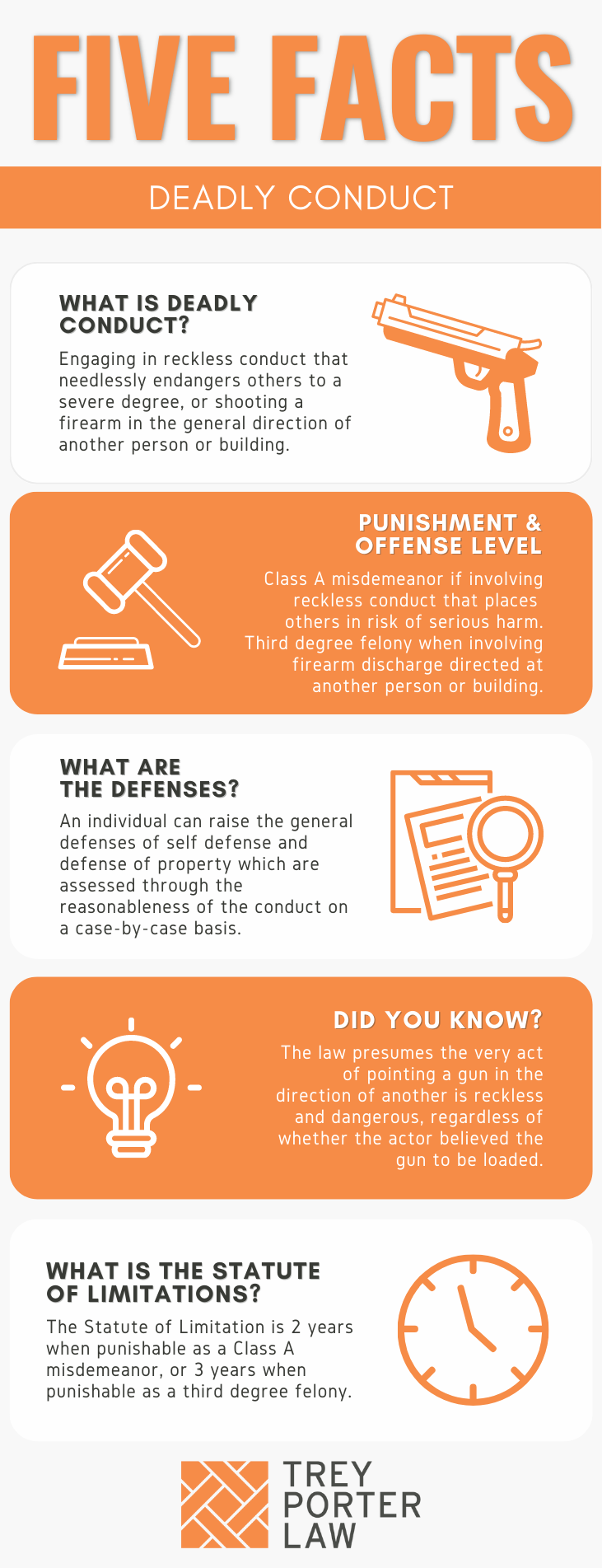WHAT IS DEADLY CONDUCT IN TEXAS?
The Texas law against deadly conduct prohibits engaging in reckless conduct that places another in imminent danger, even when there is no resulting physical harm. This law aims to discourage hazardous behavior that could lead to more severe, irreversible consequences.

WHAT IS THE DEADLY CONDUCT LAW IN TEXAS?
Tex. Penal Code § 22.05. DEADLY CONDUCT.
(a) A person commits an offense if he recklessly engages in conduct that places another in imminent danger of serious bodily injury.
(b) A person commits an offense if he knowingly discharges a firearm at or in the direction of:
(1) one or more individuals; or
(2) a habitation, building, or vehicle and is reckless as to whether the habitation, building, or vehicle is occupied.
(c) Recklessness and danger are presumed if the actor knowingly pointed a firearm at or in the direction of another whether or not the actor believed the firearm to be loaded.
(e) An offense under Subsection (a) is a Class A misdemeanor. An offense under Subsection (b) is a felony of the third degree.
WHAT IS THE PENALTY CLASS FOR DEADLY CONDUCT IN TEXAS?
Deadly conduct is a Class A misdemeanor, punishable by up to one year in jail, if a person recklessly places another in imminent danger of serious bodily injury. It is a third degree felony, punishable by two to ten years in prison, if a person fires a gun in the direction of one or more people, or an occupied house, building, or car.
WHAT IS THE PUNISHMENT RANGE FOR DEADLY CONDUCT IN TEXAS?
Deadly conduct charged as a Class A misdemeanor carries a maximum jail sentence of one year, and up to a $4,000 fine. Deadly conduct charged as a third degree felony carries a possible two to ten years in prison, and a maximum $10,000 fine.
WHAT ARE THE PENALTIES FOR DEADLY CONDUCT IN TEXAS?
A person charged with deadly conduct may be eligible for probation after a conviction, or deferred adjudication without a conviction.
However, Texas Code of Criminal Procedure article 42A.054 prohibits a judge from placing a person on probation if there is an affirmative finding of a deadly weapon. This means a person charged with using a firearm in the commission of deadly conduct might not be eligible for probation from a judge, but could receive probation from a jury after a guilty verdict.
WHAT ARE THE DEFENSES TO DEADLY CONDUCT IN TEXAS?
All of the justification defenses are available to a person charged with deadly conduct.
- Can a person claim self-defense and defense of property when charged with deadly conduct? Texas Penal Code Sections 9.31 (self-defense) and 9.41 (defense of property) may be raised by a person on trial for deadly conduct, but, as in every case, a successful defense depends heavily on the facts.In Kacz v. State, the defendant, an off-duty police officer in his personal vehicle, attempted to pull over a car at a red light. As he approached in plain clothes with his gun drawn, the driver sped off. He caught up to them, and again exited his car holding his gun. The passenger struggled with the defendant over the gun before the car again sped away. The officer fired shots at the car as it fled, and was ultimately convicted of felony deadly conduct. Because the officer’s actions prior to firing shots were illegal, he could not claim defense of self, another, or property.
- What is the charge for a drive-by shooting in Texas? Texas Penal Code Section Section 22.05(b)(2) makes a drive-by shooting a third degree felony deadly conduct. But the State must prove that the person who shot at the house, building, or car was “reckless as to whether” the target was occupied. If a person shoots at a junk car in a salvage yard at close range, it is highly unlikely that the car would have been occupied. If, however, a person shoots at a home in a neighborhood or another car on the roadway, that person may be charged with felony deadly conduct.
- Is it a crime to shoot a gun in the air? Firing a gun straight upwards, with no one else in the area, is not deadly conduct. However, if the person is within city limits, he or she may be charged under Penal Code Section 42.12 with discharging a firearm in a municipality of 100,000 people or more.If other people are in close proximity, shooting a gun into the air may still be charged as a Class A misdemeanor deadly conduct. If others were close enough that they may have been in imminent danger, that rises to the level of deadly conduct.
- Can a person be charged with deadly conduct for firing a gun inside a house? In Reed v. State, the Court of Criminal Appeals held the deadly conduct punishes a person for firing a gun from some location other than the habitation itself. This means a person may not be charged with deadly conduct by firing a gun at a particular habitation if they fired from inside that habitation.However, Texas Penal Code Section 30.01 defines “habitation” as any “structure or vehicle that is adapted for the overnight accommodation of persons,” which includes apartments. If a person fires a gun from inside his apartment in the direction of an adjoining apartment or structure, he may be charged with third degree felony deadly conduct.
WHAT IS THE STATUTE OF LIMITATIONS FOR DEADLY CONDUCT IN TEXAS?
The limitation period for deadly conduct charged as a Class A misdemeanor is two years. For third degree felony deadly conduct, the limitation period is three years.
DEADLY CONDUCT IN TEXAS
When a person comes close but stops short of seriously injuring another, the person may be charged with deadly conduct. One may intend to scare another person or persons without intending to cause physical harm, but such conduct is still a crime if the victim or victims were in imminent danger of serious bodily injury. Even pointing a gun at someone from far away may constitute Class A misdemeanor deadly conduct.
TEXAS DEADLY CONDUCT COURT CASES
The case law regarding deadly conduct in Texas most commonly deals with discharging firearms in heavily populated areas—conduct unanimously upheld to be imminently dangerous, regardless of whether a person fires the gun into the air or in the direction of a possibly occupied structure.
- In Jordan v. State, a defendant was convicted of deadly conduct after firing his gun three times into the air while being attacked by three men outside a restaurant. He testified he felt as if he had no other option, because he had already attempted to retreat from his attackers. After the fight and the shots, he went back inside the restaurant, put his hands up, put the pistol on the counter, and waited for police. The Court of Criminal Appeals held he was entitled to a self-defense instruction, because he had a reasonable apprehension of apparent danger.
















